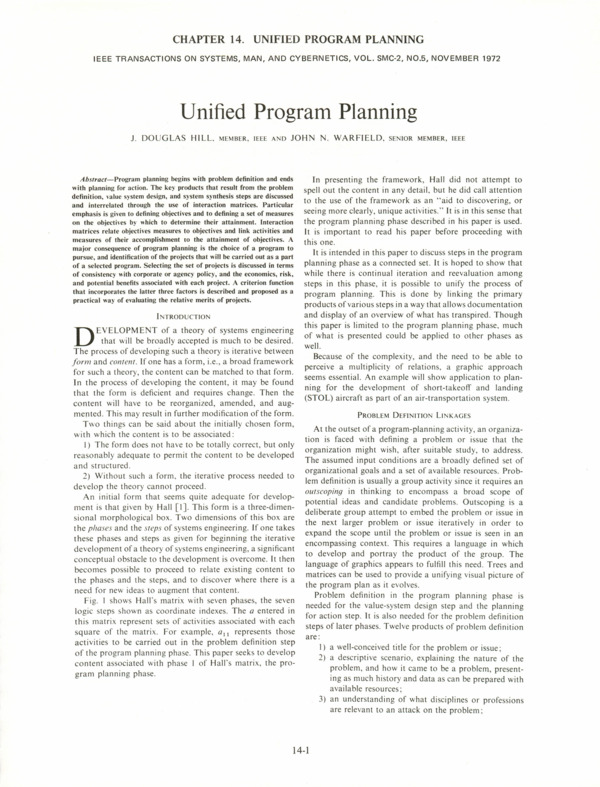This material was shipped to Fenwick Library Special Collections, George Mason University, Fairfax, VA on 23 October 2000. Warfield's description: "The article is a presentation of philosophical and mathematical fundamentals for techniques in the participative methodologies, for use in problem solving. Proceeding from problem definition, a value system design and system synthesis steps are discussed, and interrelated through use of interaction matrices. Particular emphasis is given to defining objectives and measuring the attainment of objectives."
TOPICAL HEADINGS in the published article: Problem Definition Linkages Value System Design Linkages System Synthesis Linkages Decision Making in Program Planning FIGURES in the published article Fig. I. Hall activity matrix. Fig. 2. Example of self-interaction matrix. Fig. 3. Example of cross-interaction matrix. Fig. 4. Interactions of importance in problem definition for program planning Fig. 5. Form of objectives tree. Fig. 6. Objectives self-interaction matrix corresponding to objectives tree shown in Fig. 5. Fig. 7. Interaction of objectives with constraints, alterables, needs, and societal sectors. Fig. 8. Relating objectives measures to objectives. Fig. 9. Linkages for system synthesis. Fig. 10. Program planning linkages. Fig. 11. Example of chain of binary interaction matrices.
This paper is important because of the date. As an article in 1972 in the IEEE journal, it was most likely the earliest widespread information on Warfield's new ISM processes although Warfield had published one other paper on the subject "Participative Methodology for Public System Planning." a few months before the IEEE article. This planning system would resurface in 1985 under the name "Quality Function Deployment (QFD)" and be attributed to Mitsubishi by two authors from Harvard and MIT respectively, writing in the Harvard Business Review.
The journal article Unified Program Planning was reprinted in Warfield, J. N. & Hill, An Assault on Complexity, Battelle Monograph No. 3, ( Columbus, OH: Battelle, 1973), 14-1 - 14-12. Our digitized home copy of Unified Program Planning is from a spiral-bound version of Assault on Complexity. In my scan, the Chapter 14 heads the page, because Unified Program Planning was Chapter 14 of the book Assault on Complexity. Figure 11 is so large that I had to scan it to two pages. However, to better represent Figure 11, I made another scan. This time I used the foldout of Figure 11 which had been shrunk to 8x11 inches, from an old fuzzy photocopy. It was fuzzy, but an improvement. If seen all on one page it is easier for the reader to grasp the complete sequence of the math. I don't know if GMU Library has the offprint from IEEE Transactions, or just the same thing I have. Anyway, Unified Program Planning is clearly readable in the Battelle monograph Assault on Complexity, which is available in many libraries.
" r.w. 21 September 2012 r


